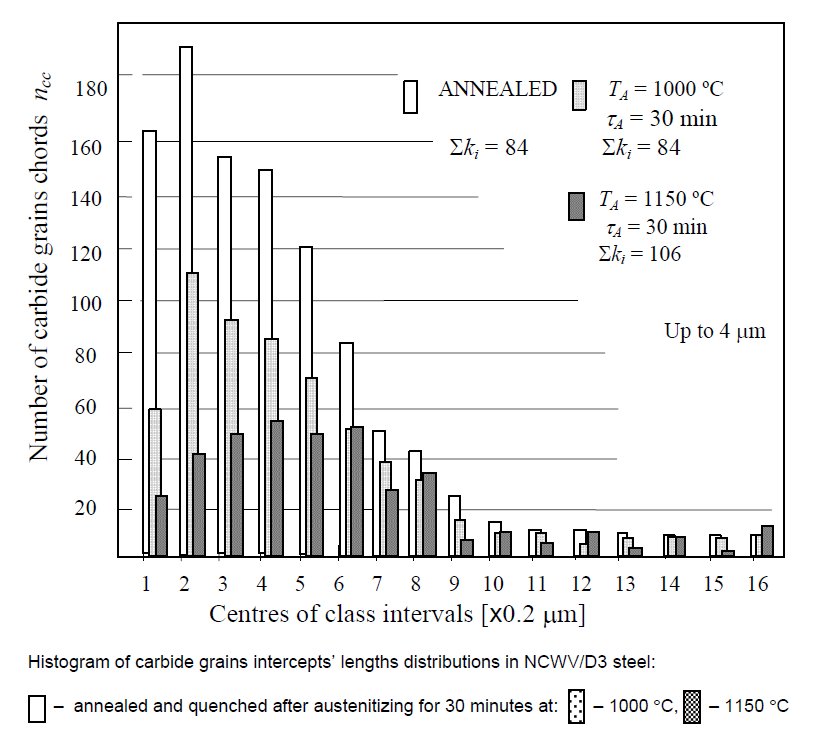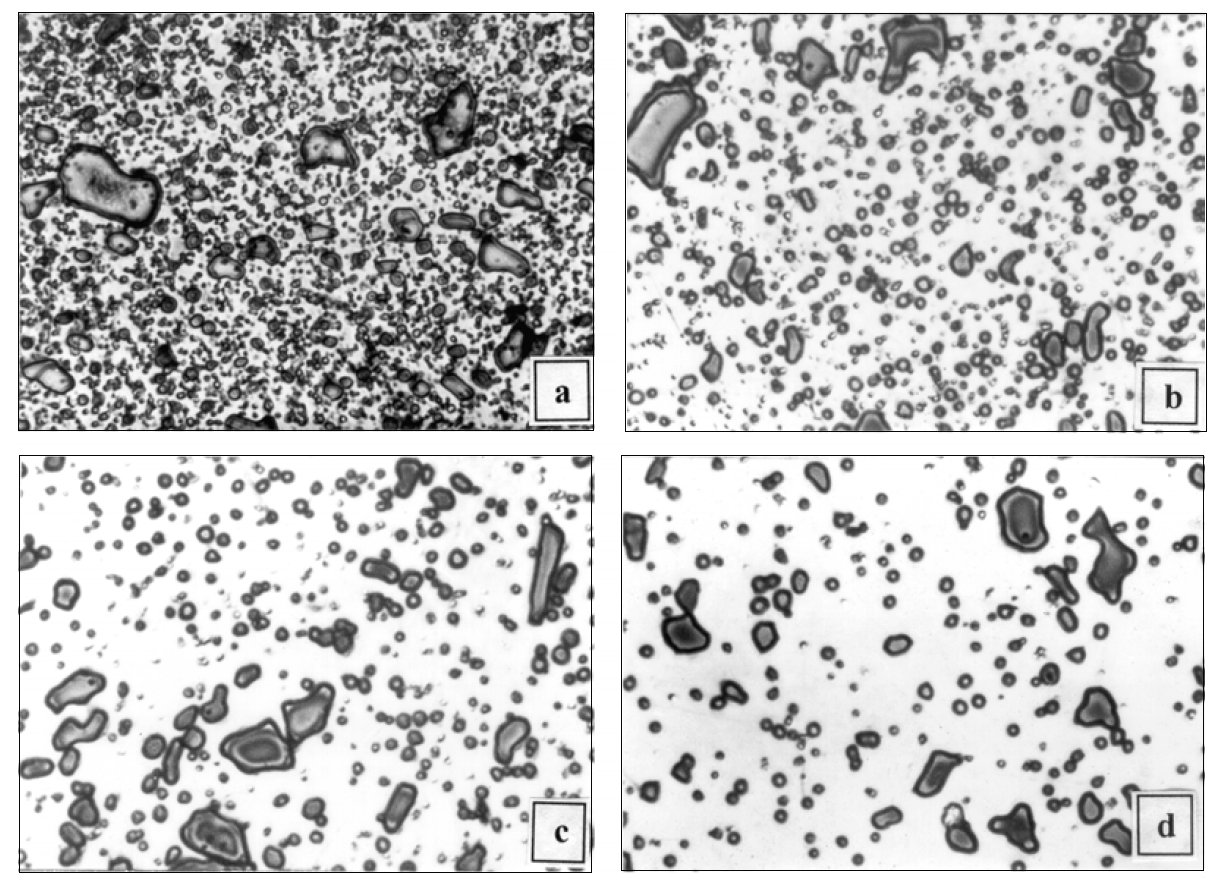
Alphabetical Index
Chemical Composition of Steels
Keyword Search
Steel Names
Alloyed Steels
Carbon Steels
Cast Irons
Chromium Steels
Cold Work Tool Steels
Creep Resistant Steels
Hot Work Tool Steels
Molybdenum Steels
PM steels
Stainless Steels
Structural Steels
Tool Steels
Vanadium Steels
White Cast Irons
M2C Carbides
M3C Carbides
M7C3 Carbides
M23C6 Carbides
MC Carbides
Light Microscopy
EDS/WDS Microanalysis
Scanning Electron Microscopy
Transmission Electron Microscopy
X-Ray Diffraction
Help
Contact Us
Home
Carbides in NCWV/D3 steel

Table 1: Composition of material for the study, NCWV/D3 steel, in wt%

Figure 1: Histogram of carbide grains intercepts’ lengths distributions in NCWV/D3 steel.

Figure 1: Picture of carbide grains in NCWV/D3 steel: (a) in the soft annealed state, (b,c,d) quenched after austenitizing for 30 minutes at: (b) 950 C, (c) 1050 C, and (d) 1150 C. Murakami’s reagent was used for etching. Magnification 1,000x.
Carbide name: Carbides
Record No.: 730
Carbide formula: No data
Carbide type: No data
Carbide composition in weight %: No data
Image type: LM
Steel name: NCWV/D3 steel
Mat.No. (Wr.Nr.) designation: 1.2080
DIN designation: X210Cr12
AISI/SAE/ASTM designation: AISI D3
Other designation: No data
Steel group: Cold work tool steels
Steel composition in weight %: See the table 1.
Heat treatment/condition: Heat treatment of samples of diamter = 12 mm, length = 60 mm, assigned for determination of carbides contents using method of electrolytic extraction at 900 to 1150 °C and austenitizing times of 10, 30, and 90 minutes, was performed in a furnace with protective environment/atmosphere of technically clean nitrogen. The accuracy of temperature control was ±2 °C. After the austenitizing the samples were quenched in a hardening oil. To avoid eventual decarbonated layer the samples surface was ground on centreless grinder to remover the layer of thickness at least 0.5 mm.
Note: The NCWV/D3 tool steel was the subject of the study. In the course of the investigation carried out it was found that during austenitizing of the steel the carbides contents decreased from 24.84 wt% in the annealed state down to 13.33 wt% after austenitizing at 1150 °C during 30 minutes. It was also stated that the carbides contents in the quenched steel after austenitizing in the temperature range from 900 to 1150 °C during 30 minutes may be determined from the equation. Dissolution of carbides during austenitizing brings about the increase of elements Cr, W, and V contents in austenite up to 7.27%, 1.06%, and 0.086%, respectively, after austenitizing at 1150 °C during 30 minutes. It was also noticed that there is a rectilinear correlation between the contents of dissolved carbides in austenite and the contents of Cr and W in matrix of the tool steel quenched after austenitizing in the temperature range from 900 to 1150 °C and constant time of 30 minutes.
The electrolytic extraction of carbides was carried out in a 5%-HCl acquaeous solution of specific gravity of 1.19 g/cm3, with the current density of 10 mA/cm2. The extraction time was 18 to 20 hours. The carbides extraction method in details has been presented in literature. Percentages of Cr, W, and V in matrix of the quenched steel samples were determined by performing chemical analysis of electrolytes obtained after the carbides extraction. The percentage of chromium was determined by a potentiometric method whereas of tungsten and vanadium by a colorimetric method.
According to the study results presented in for the experimented steel, and by Geller for the X12M steel of similar composition, apart from the chromium carbides of M7C3 type, the carbides of M23C6 type occur in very small amount which dissolve completely in austenite during austenitizing steel at 1050 °C during 30 minutes [8]. The occurrence of carbides of M23C6 in NCWV/D3 steel was also identified by Kaluza.
Big primary carbides of the investigated NCWV/D3 steel annealed and quenched after austenitizing in the temperature range from 900 to 1150 °C for 30 minutes usually possess irregular shape, whereas lesser secondary carbides possess spheroidal or close-to-spheroidal shape.
It results from histograms presented in Fig. 1 that in rods of diameter 13 mm of the investigated NCWV/D3 stee obtained by forging and then soft annealed the distribution of carbide grains intercepts’ lengths is close to logarithic-normal with carbides of 0.4-mm intercepts’ length being the most numerous fraction.
Qualitatively similar distributions were obtained in samples of the quenched steel after austenitizing at 1000 and 1150 °C, with decreasing number of carbides of the least dimensions, that is of intercepts’ lengths down to about 1 ěm, occurring.
In the quenched steel after austenitizing at 1000 °C during 30 minutes still the most numerous fraction are the carbides of intercepts’ lengths of 0.4 ěm whereas after austenitizing at 1150 °C the carbides fractions of intercepts of 0.6 to 1.2 ěm. Micrographs of carbides of the investigated NCWV/D3 steel annealed and quenched after austenitizing at 950, 1050, and 1150 °C respectively, for 30 minutes are presented in Fig. 2.
Links: No data
Reference: Not shown in this demo version.